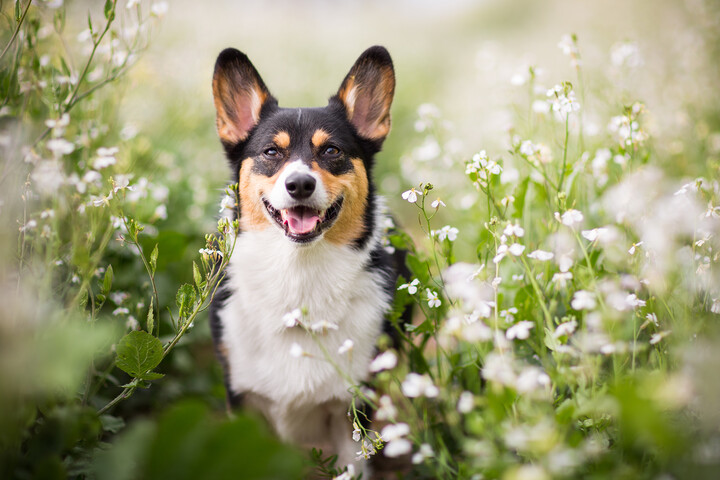Keep your dog's habits and character in mind when creating your outdoor space.
Watching your furry friend enjoy the garden, lounging on a sunny patio, happily running on paths and sniffing at foliage is all wonderful—until it's a disaster. Until pots get knocked over, the lawn is a matted and rutted mess, and precious spring bulbs are dug up. Your dog and garden don't have to become a nightmare combination if you keep your four-legged family member in mind when designing your green space.

Gardening with dogs—or dog-scaping—is a way that identifies problems and hazardous plants, uses creative and green solutions and ultimately respects the most common canine behaviors. Fundamentally, it's coming to terms with the fact that you own a dog and you need to relinquish some control and put aside total perfection. You and your dog naturally change over time; let your landscape grow with you, and it will soon become a garden to wag about. Here are seven things to consider when landscaping a dog-friendly garden.
Related: How to Stop Your Dog from Digging Under the Fence
Observe your dog's habits and routines.
Your dog's breed can offer some important information about their behavior. For example, beagles and terriers are more prone to digging while Labrador retrievers are prone to chewing, especially when young. Nonetheless, every individual dog has a different personality too, so go with what you see: is your dog a digger, an escape artist, a patroller, a fence barker? Focus on solutions to those specific problems.
Install sturdy fences and gates.
To ensure your dog doesn't go on a walkabout, all major gates should be self-closing and fences high enough to discourage the canine escape artist. Also consider lining fences with an underground barrier, such as chicken wire, to prevent the persistent tunneler. Want to keep your yard clutter-free? An electronic dog fence is an attractive alternative. Electronic fences allow you to set up invisible boundaries that your dog can't jump over or dig under. Your dog gets too close to the boundary? The receiver on the collar warns the dog with a high pitch sound.
Replace all or part of your lawn.
Don't waste time and money on lawn care when it comes to dog-friendly landscaping. Most dog urine burns grass and leaves unsightly spots. Plus, many dogs enjoy digging up lawns, which generally results in mud being tracked into the house. To create a problem-free and low-maintenance landscape, ditch your lawn and add more permeable hardscape. Concrete, brick, wood, flagstone, or smooth river rocks are all popular hardscape materials among dog owners. Tip: Stay away from using sharp-edged crushed stones that can damage an animal's feet.
Don't plant the perimeter—a dog will patrol his territory.
If your garden is fenced in, this is an important concept to consider. Some dogs will cruise perimeters and enthusiastically investigate every time it hears a noise. This, unfortunately, translates into plants being crushed and trampled, especially tender ones. A good solution? Observe your dog's patterns and clear out a small (three feet wide) and simple perimeter paths along a frequently visited fence line and mulch to provide a mud-free surface. Also consider planting a sturdy hedge in front of the dog runway. Some evergreen plants to consider include silverberry, juniper, crimson bottlebrush, southern wax myrtle, sweet osmanthus and Camellia japonica.
Use more containers and raised planter boxes.
For herbs, vegetables, and less durable plants, consider planting higher up in pots and containers. This is an effective way to introduce color and tender plants onto decks, patios, and other heavily traveled areas. If you want to plant in regular beds, protect flowers, bulbs, or ground covers by installing short rounded stakes just below the foliage as this helps discourage dogs from lying in the beds.
Select plants carefully.
Young dogs and certain breeds chew on anything—including poisonous plants—so before planting a new favorite flower, check out this important toxic and non-toxic plant list. And to get you started, here are some dog-friendly (meaning safe) plants: For a sunny spot, consider crepe myrtle, Euonymus, Abelia, kangaroo paw, viburnum, weigela, and lavender. Sturdy ground covers include carpet bugle, elfin and wooly thyme, silver carpet, and dwarf mondo grass. For shady spots, ferns (except asparagus ferns) lily turf, begonia, mock orange, and carex. Urine resistant plants include feather reed grass, holly fern, viburnum, Mexican sage, New Zealand flax, and red twig dogwood.
Practice organic gardening.
Even without a dog in mind, it's smart to avoid harmful chemicals, pesticides, and weed killer, which can be harmful to you, your family, and the earth. Choose organic fertilizers instead, but also be aware that dogs are especially drawn to blood, fish, and bone meal; if these prove problematic, try a plant-based fertilizer. For natural pest control, plant flowers and herbs like cosmos, cilantro, sweet alyssum, and yarrow that attract beneficial bugs and do the exterminating for you.